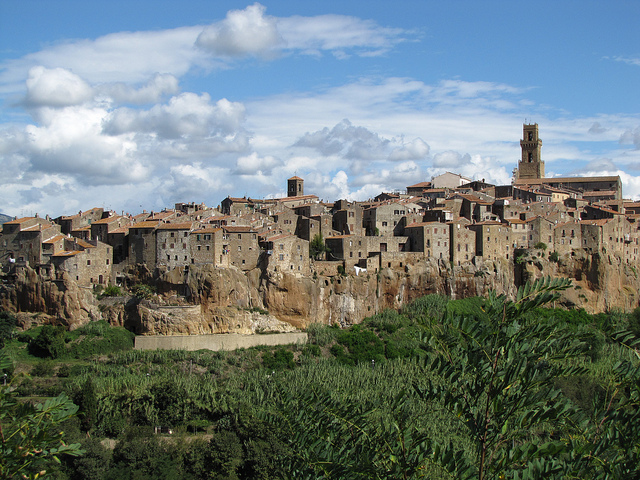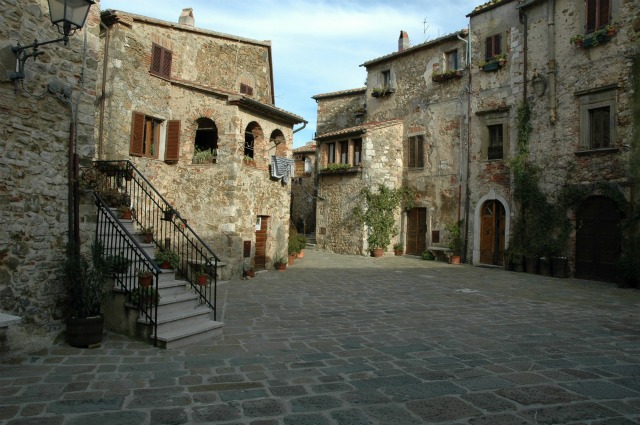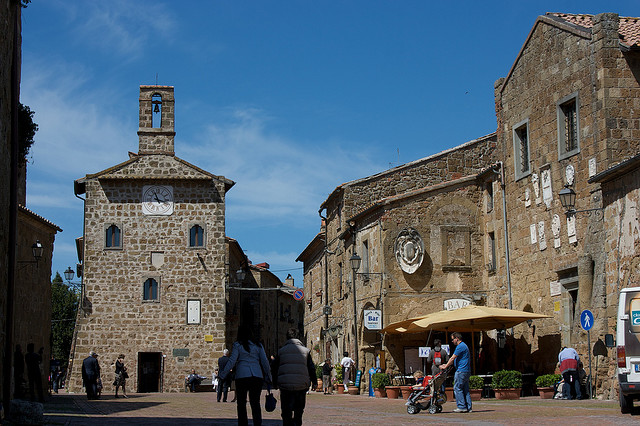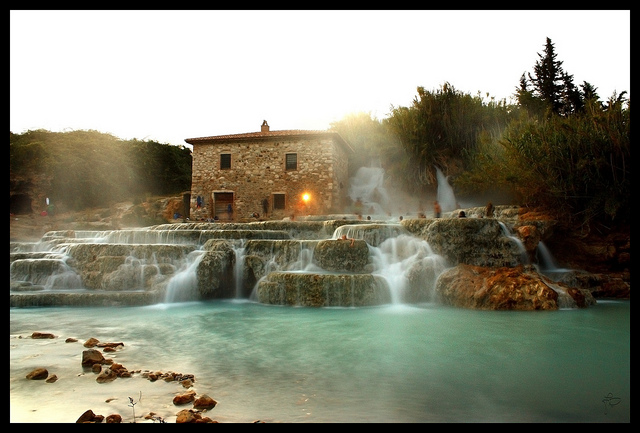The Tuscan Maremma Travel Guide
Although Italy isn’t an overly large country, there are still places that are still relatively undiscovered by the tourist hordes – even in arguably the most popular region of Tuscany. The Maremma is just such a place, and in this guest post by Elisa Scarton you’ll find out why it’s an area favored by many vacationing Italians (and why you should think about adding it to your Italian itinerary, too).
The Tuscan Maremma

If you have never heard of the Tuscan Maremma then you’re missing out on one of the most genuine and humbly beautiful territories left in Italy.
Think quiet country towns where traditions are still celebrated in vibrantly colored festivals. Think sunflower-flooded fields and open spaces. Think locals who still sit in front of the sandstone homes they have owned for generations. And think dishes prepared following family recipes with not even a whisper of a tourist menu in sight.
Intrepid Italians have been heading to the Tuscan Maremma, tucked inconspicuously between the borders of Southern Tuscany and Lazio, for decades. They come here for the territory’s unparalleled natural beauty, which transitions from gorgeous beach and breathtaking nature reserve to snow-dusted mountain peak, all in a matter of kilometers.
Far from the bright lights and tourists of nearby cities Rome, Florence and Siena, the Tuscan Maremma has also ferociously maintained its heritage and culture, first shaped by the pre-Roman Etruscans, but influenced by medieval warlords, Spanish invaders and Renaissance dukes.
But best of all, the Tuscan Maremma has kept its provincial charm, giving you the chance to experience the Tuscan countryside as a true local, even if it is only for a little while.
On this page, you’ll find information about the Tuscan Maremma including how to get there and what to do once you arrive.
Navigating the Tuscan Maremma

If you look up the Tuscan Maremma on a map, you won’t find it. Officially the territory goes by the rather dry name Provincia di Grosseto or Grosseto Province, but the locals have been calling it the Maremma for centuries and no one can seem to find a good enough reason to stop doing so now.
In the past, the Tuscan Maremma was a cluster of very independent states, which has left its modern residents with almost no inclination to band together to form one unified provincial transport system. This can make traveling on public transport fairly difficult. Some areas are serviced by a very efficient train network, but most aren’t. That said, if you have patience and aren’t easily fazed then you can reach almost every corner of the territory by bus.
Still, you’re better off renting a car. The Tuscan highways in the territory aren’t heavily trafficked so you don’t have to worry about aggressive drivers. If you’re flying into the Tuscan Maremma then pick up a car at the airport. The two closest airports are Rome’s Fiumicino and Pisa’s Galileo Galilei, depending on where you’re staying, and this is where it gets tricky. Geographically, the Maremma covers almost one third of Tuscany. That means it will take you at least three hours to get from one end to the other, if you’re lucky.
Whether you’re traveling by car or public transport, you can’t hope to see all of the Tuscan Maremma in one hit unless you want to spend the majority of your vacation in transit. The best thing to do is make a list of everything you want to see before you leave and plan your journey around that. If you want beaches, base yourself on the Argentario Coast. If you want to see the glory of the Etruscan empire, head for Vulci and the Fiora Valley. While if you want to immerse yourself in naturalistic pursuits, set yourself up in Monte Amiata.
Where to Stay in the Tuscan Maremma

If you couldn’t possibly imagine staying in anything but utmost luxury than the Tuscan Maremma has a handful of high-end hotels. You’ll find them in the main tourist spots – Grosseto, Massa Marittima, Saturnia and the Argentario Coast.
But as magnificent as these hotels are, they’re not going to offer you a real sense of the Tuscan Maremma. So much of this territory’s charm lies in the fact that it is a provincial destination, unfussy and untouched by excessive tourism, so if you stay in a five star hotel, you’re kind of missing the point.
You’d be better off booking a B&B or agriturismo. Not only are both considerably cheaper than any hotel, they’re also family owned, so you’ll wake up to a homemade breakfast of local sweets and coffee, usually included in the price, and plenty of friendly banter from the owners.
As an added plus, agriturismi are usually working farms. They’ve been a staple in the Maremma since a few plucky farmers realized tourists wanted to stay on their considerable and considerably beautiful farmlands to experience the Tuscan lifestyle.
Most agriturismi offer you the choice of room or apartment, depending on the size of your group, and are usually converted historical buildings decorated in the typical country Maremman style – think vintage furniture and exposed beams.
When it comes to entertainment, most agriturismi will have a pool at the very least, but you could also be treated to wine tasting sessions, cooking and horse riding lessons, olive oil and cheese making demonstrations, fishing trips and bike tours, the list goes on. Not to mention, there are always the hectares of open countryside for you to walk through or the kids to run wild through.
What to Do in the Tuscan Maremma

The Maremma is one of the few places in the world that can really claim it has something for everyone.
If you want beaches, you can while away the days on the crystal clear sands of the Argentario Coast, between Porto Ercole and Porto Santo Stefano. Not impressed? Then book a tour to Giannutri Island. A breathtaking marine park, the island is only an hour from the mainland, giving you plenty of time to explore its beauty above and below the waterline.
If you’re looking for a bit of history, pull on your sightseeing boots and pick an era. Every century from pre-historic to Etruscan, Roman, Medieval and Renaissance is represented somewhere in the Tuscan Maremma. But for a quick fix, don’t miss Vulci, one of the abandoned capitals of the Etruscan empire, Etruria, and now a massive open-air museum.
If you’re a naturalist by nature then you’re literally spoilt for choice in this corner of Southern Tuscany. Every year, hundreds of cycling enthusiasts pack their bags and their bikes and head for the trails that weave their way through the Tuscany Maremma’s many nature parks. Those of us without bikes need not worry, there are plenty of other ways to appreciate the territory’s incredible beauty including hiking, horse riding, skiing and sailing.
And finally, if you’re itching for a spa holiday, forget about all the other activities mentioned above and head straight for Saturnia. The Tuscan Maremma is trumped as Italy’s hottest hot spring destination and Saturnia is its capital. It’s there that you’ll find the paradisiacal Cascate del Mulino hot springs, where you can relax in 37°C water for free with the gorgeous Tuscan countryside as your backdrop. You’ll never want to leave.
Then of course, there’s the food, but you’re in Tuscany after all, so it should come as no surprise that Maremman fare is some of the finest you’ll have ever tasted!
About the Author:
 Elisa is an Australian journalist who came to Tuscany for a year, fell in love, how cliché? And decided to stick around. Not one to keep paradisaical holiday destinations to herself, she now writes a Tuscan travel blog and online travel guide about the infinitely beautiful Tuscan Maremma, so that others can get a taste of la dolce vita.
Elisa is an Australian journalist who came to Tuscany for a year, fell in love, how cliché? And decided to stick around. Not one to keep paradisaical holiday destinations to herself, she now writes a Tuscan travel blog and online travel guide about the infinitely beautiful Tuscan Maremma, so that others can get a taste of la dolce vita.
photos by: ComunicaTI, Elisa Scarton (and may not be used without permission), strato56, JarleR